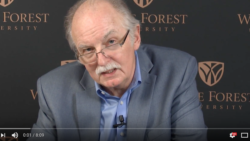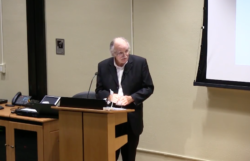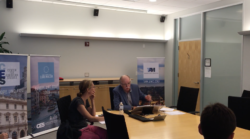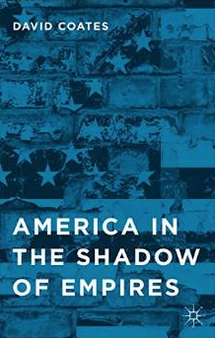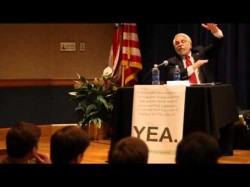Poverty Amid Plenty – America’s Continuing Shame
The current wave of mass protest against Wall Street excess has completely reframed the public conversation in the United States. The “deficit problem” with which Washington was consumed in the first half of 2011 has not vanished from the political agenda, but its resolution will now have to be achieved against the background of a growing understanding of the sheer scale of current income and wealth inequality. If the Republicans in Congress have their way, the politicians may yet cut entitlements programs for the poor while declining to raise taxes on the rich. But if that is how the deficit problem is eventually resolved, that resolution will be more extensively recognized as class-biased in its character and impact than would have been the case before the OWS protests began. The super-rich are invisible no more, and are now being held to account.
Even the Congressional Budget Office has recently joined the fray, publishing last week Trends in the Distribution of Household Income Between 1979 and 2007. The CBO reported rises in the average real after-tax household income of the top one percent of the U.S. population of 275% between the two dates, as against a rise of 65 percent for the top 20 percent of income earners, just under 40% for the top 60 percent of income earners, and a tawdry 18 percent rise for the bottom 20 percent.[1] All the resulting headlines focused in on that top one percent and its staggering 275 percent gain in income. “Top Earners Doubled Share of Nation’s Income, Study Finds,” was the ruling headline in The Washington Post in the immediate wake of the report.[2] “Incomes rising fastest at the top” was the headline on October 19’s EPI Economic Snapshot.[3] “Another word for what’s been happening might be theft” was the way Eugene Robinson put it in his opinion piece in that same Washington Post.[4]
All that is true of course, but even so a word of caution is in order. Though fully justified by the data in the report, those headlines help frame the public conversation in ways that might yet leave progressive forces vulnerable to rapid pushback. For by focusing on the super-rich, such headlines leave their authors (and us) open to the counter-argument that since 2007 trends have been reversed – that the rich are no longer as excessively rich as they once were, and so are correspondingly less in need of punitive taxation than was originally the case. By focusing on the CBO Report, the headlines also open us to the argument that even the bottom 20 percent of American income earners are becoming steadily better off – so why make a fuss if their entitlements programs are now marginally eroded in the name of a wider American need for fiscal restraint?
We can expect both responses. Indeed both are already underway. The Cato Institute’s Michael Tanner recently argued that in the wake of the 2008 recession “the rich are earning a smaller proportion of U.S. income” than before, and that “interestingly, the decline in earnings by the rich has corresponded with higher unemployment and rising poverty overall. We are all poorer,” Tanner said, “but at least we are more equally poor. Hooray.”[5] That response should not surprise us. Commentators on the Right have long argued that tax data fails to accurately measure income and wealth inequality in the United States, and invariably overstates the riches of those at the top of income and wealth tables.[6] Some have also long argued that the American poor are not really poor. They are not as poor as the income data would suggest, because fiscal transfers (earned income tax credits and the like) offset much of that poverty.[7] They are not poor by historical standards – they live better now than many middle class families did two/three generations ago. They are not poor when compared to the genuinely poor in the global economy: the American poor have cars, fridges, televisions, cell-phones and often generous living space – things that are still not available to the emerging middle class in many developing societies even now, let alone to the third world poor.[8] And if some Americans are poor when measured against official U.S. poverty standards, then much of that poverty is self-induced. Had the young single mothers now trapped on welfare only stayed at school, got a job and delayed having children until they were financially secure, they could easily have slipped into the bottom rungs of the American middle class.[9] So at least many conservatives regularly argue!
If that dismissal of American poverty is not to hold sway, we need to go beyond the statistics in the CBO Report, to say other things about the American rich and the American poor. One thing we need to say is that – as the CBO Report indicates – both the rich and the poor are still with us. The poor have not gone away, and their conditions of life remain seriously impaired when compared to those enjoyed by the rich. Another thing we need to say – following Eugene Robinson – is that there are poor Americans primarily because there are also rich Americans. The rich and the poor in contemporary America are not separate categories of people, unconnected and dissimilar. Instead the two categories are organically linked: linked because the rich and the poor are ultimately just people sharing a common country and economy; and linked because in a world of scarce resources, the excessive claims of the privileged deny full access to those resources by the less privileged. In a very real sense, the pursuit of rising incomes in contemporary America is a zero-sum game – if the man in the big office takes a big salary hike, that hike leaves less in the salary pool for those working in the smaller offices behind – and like all games, this one only works if everyone follows the rules. Right now, the rules in America’s zero-sum income game are heavily stacked in favor of the excessively wealthy and against the excessively poor; and because they are, they are rules that we need to change.
No matter how often some conservative commentators deny it, there is still massive poverty in the contemporary United States, the bulk of which is involuntarily acquired. Of course, if we are crazy enough to only measure poverty against some absolute and timeless scale, then there is no real poverty now because everyone in the contemporary United States lives so much better than did people in the past, since technological progress here has been so great over the last century as a whole. But to measure poverty in that way is to trivialize the issue. Better therefore to define poverty either against a basket of goods representing a minimum acceptable standard of life (as we do here in the United States when calculating the official poverty rate), or against a percentage of median income (say 60 percent, as do the Europeans); and if we do, we must see overwhelming evidence of the persistence of genuine poverty in the midst of all our contemporary affluence: evidence such as this.[10]
l. The official poverty level is currently 15.1 percent, and the twice poor (those living within one income tranche of the poverty level for their scale of family) currently make up nearly one American in three. New data from the Census Bureau actually points to an increase in the scale of U.S. poverty – poverty is currently on the rise in America, back in percentage terms in 2010 to the level last seen in 1998: and in absolute numbers – at 46.2 million people – greater than at any time since poverty figures were first calculated in the 1960s. We also have new data on the number of children in poverty – that number increased in 2010 for the fourth year in a row – to reach nearly one child in four (22%). The figure for child poverty has not been that high since 1993, and stands in stark contrast to the scale of child poverty elsewhere in the industrialized world: 3.7% in Denmark according to the OECD, 8.3% in Germany, and 9.3% in France.[11]
2. We also have data on the scale of hunger and food insecurity currently prevalent among the ranks of the American poor. In 2009 15.6 million children received food stamps each month, a 65% increase on the number a decade ago.[12] As the recent CAP report put it, the recession and tepid recovery together “swelled the ranks of American households confronting hunger and food insecurity by 30%. In 2010 48.8 million Americans lived in food insecure households….12 million more people than faced hunger in 2007.” That number – 48.8 million – represents 16.1% of the total US population: nearly one American in six currently facing tough choices on a daily basis about what they can and cannot afford to spend. “In 2010 nearly half of the households seeking emergency food assistance reported having to choose between paying for utilities or heating fuel and food. Nearly 40 percent said they had to choose between paying for rent or a mortgage and food. More than a third reported having to choose between their medical bills and food.”[13]
3. We also have solid data on the level of involuntary unemployment. Fourteen million Americans are currently without work in an economy that created only 103,000 jobs in September and actually lost 34,000 in the public sector. Local government payrolls are at their lowest since 2005, white collar unemployment has now run at twice its pre-recession level for 29 consecutive months, the number of long-term unemployed is now 6.2 million, and the under-employment rate is 16.5%: 25.8 million workers either unemployed or trapped in involuntary part-time employment. There are currently four unemployed workers for everyone one job opening. Unemployment among Hispanic workers is currently 11.3% and among African Americans 16.0%, among whites 8.0%, and overall 9.1% ‘The U.S. economy is currently generating 6.6 million fewer jobs than it did before the 2008-9 recession.”[14] Herman Cain may blame the unemployed for their condition, but it seems fairer to point the finger of responsibility at the recession itself.
4. The data also shows a persistent racial dimension to poverty (as well as to the distribution of income and wealth) in the contemporary United States. The poverty rate among Hispanic Americans is currently 26.6% and among African Americans 27.4%. The equivalent figure for Asian Americans is 12.1% and for white Americans just 9.9%. A third of Hispanic children in the U.S. live in poverty. More than a third of African-American children do. The wealth gap between Whites, Black and Hispanics is at a record high. The median net worth of white households in 2009 was $113,149; of Hispanic households $6,325; and of black households $5,677 – “lopsided wealth ratios [which] are the largest since the government began publishing such data a quarter of a century ago and roughly twice the size of the ratios that had prevailed between these two groups for the two decades prior to the great recession that ended in 2009.”[15] The White-Black wealth ratio is currently close to 20:1.
5. We have solid evidence too of an increase in the number of Americans without health care coverage – 900,000 more in 2010 than in 2009, and nearly 50 million in total. As the Kaiser Foundation report, The Uninsured: a Primer recorded in December 2010, “the steady decline in employer-sponsored health coverage since 2000 and the current weak job market largely explain the growing numbers of uninsured.” Affecting Americans of “all ages, races and ethnicities and income levels,” and in spite of the link between work and benefits in our current welfare system, “more than three-quarters of the uninsured, “ the Primer said, “come from working families – four in ten of the uninsured are individuals and families who are poor.”[16]
6. Finally, we have data on the limits on social mobility in contemporary America. Even before the financial meltdown and resulting recession, the best evidence we have suggests “that children from low-income families have only a 1% chance of reaching the top 5% of the income distribution, versus children of the rich who have about a 22% chance”; that African-American children born into the bottom quartile are twice as likely to stay there as white children born to parents with similar income; and – perhaps most shocking of all – that U.S. rates of intergenerational mobility are now lower than those in France, Germany, Sweden, Canada, Finland, Norway and Denmark.[17]
All this adds up to one clear truth: most Americans are not poor because they made bad choices in relation to education, work and the timing of children. Most Americans are poor because they can’t find work in an economy now beset with both recession-created and structurally-induced unemployment. People are without work because the financial crisis of 2008 generated a recession that destroyed jobs. People are without work because whole industries have been outsourced to cheaper labor markets overseas. Textile and furniture employment in my state – North Carolina – has now largely relocated to South Asia and China. Under those conditions, people without work are victims, not architects, of their condition – and need to be honored as such. And if there is a cycle of deprivation – if the children of the poor have a greater propensity than others to stay poor – then those children are themselves innocent recipients of the consequences of the one involuntary decision we all make: namely our choice of parents. People may, by their own actions, move themselves around on the ladder of inequality: but for that movement to leave those at the bottom of the ladder mired in poverty, there have to be badly resourced lower rungs on that income ladder. If we want all Americans to escape poverty, we as a society have to stop creating poverty slots at the bottom of the ladder. We will get rid of poverty by shortening the ladder and by raising its base. We will not get rid of poverty by urging the poor to climb harder, leaving others behind to fill the poverty slots they have at least temporarily vacated.[18]
Given the severity of the deprivation at the bottom of the contemporary U.S. income ladder, it is hard to find much sympathy for the problems of the American super-rich, now (according to their defenders) suffering diminutions in their wealth because of poor returns on the stocks they hold. Maybe 2008 and 2009 were marginally difficult years for the top one percent of American income earners, but any sympathy for them would still be largely misplaced. For when all the data is in, 2010 and 2011 will no doubt have seen the re-establishment of the upward trajectory of their income and wealth;[19] and even if it has not, the super-rich will still hold 40 percent of our entire wealth and monopolize a quarter of the total American income bill.[20] The fact that the top one percent takes so much of our collective income and wealth means that there is less for the rest of us. So unless the rich can prove that their disproportionate claim on income and wealth stimulates investment and job creation from which the rest of us benefit – unless they can prove that trickle-down economics works – we will have to keep on saying, as the OWS protesters do, that income and wealth inequality on the scale we are experiencing now is best understood as theft.
Wealth creation is, after all, a collective endeavor. As Elizabeth Warren said, no one in America gets rich alone. The rules governing income and wealth distribution are socially determined, and for the last three decades in the United States, those rules have been stacked in the rich’s favor. With the scale of poverty and unemployment now around us, it is time for those rules to be reset. There are more than statistics at play here; and in truth the detail of the income and wealth statistics matters less than we might think. For no matter how the income numbers vary month by month or year by year, they consistently demonstrate that levels of inequality in contemporary America run remarkably deep. Because they do, they necessarily raise for all of us basic issues of morality. It is simply not right that children should be denied a level playing field on which to begin their pursuit of the American Dream; and it is indefensible that people of color should be denied the right to participate fully in the society than their forebears did so much to create. In the end, setting the detailed statistics aside, it is vital that we ask more fundamental questions. To what degree are we all fellow-citizens in this society, and to what degree are we not? Are we one America or are we two? If we are one America – or at least if we want to be one America, united and at social peace – it is surely time to make the alleviation of poverty our number one priority. Inside the 99 percent, it is surely time to focus hard on the needs of the bottom fifth.
[1] Trends in the Distribution of Household Income Between 1979 and 2007, Washington DC: Congressional Budget Office, October 2011.
[2] Robert Pear, “Top Earners Double Share of Nation’s Income, Study Finds,” The Washington Post, October 25, 2011.
[3] Lawrence Mishel, ‘Data on income gains supports 99ers gripes,” Economic Snapshot, Washington DC: Economic Policy Institute, October 19, 2011.
[4] Eugene Robinson, ‘the study that shows why Occupy Wall Street struck a nerve,” The Washington Post, October 27, 2011: available at http://www.washingtonpost.com/opinions/the-study-that-shows-why-occupy-wall-street-struck-a-nerve/2011/10/27/gIQA3bsMNM_story.html
[5] Michael Tanner, Equally Poorer, Washington DC: The Cato Institute, October 26, 2011: available at http://www.cato.org/pub_display.php?pub_id=13803
[6] See for example, Alan Reynolds, Has U.S. Income Inequality Really Increased? Washington DC; Cato Institute Policy Analysis, No. 586, January 8, 2007: available at http://www.cato.org/pub_display.php?pub_id=6880
[7] But less now than in the past, according to the CBO report: “The equalizing effect of transfers and taxes on household income was smaller in 2007 than it had been in 1979…In 1979, households in the bottom quintile received more than 50 percent of transfer payments. In 2007, similar households received about 35 percent.” (Trends…., p. xii)
[8] See Nicholas Eberstadt, The Poverty of “The Poverty Rate”, Washington DC: American Enterprise Institute for Public Policy Research, October 16, 2008: available at http://www.aei.org/issue/28926
and Robert Samuelson, “Why Obama’s poverty rate measure misleads,” The Washington Post, May 31 2010: available at http://www.washingtonpost.com/wp-dyn/content/article/2010/05/30/AR2010053003296.html
[9] See Robert Rector and Kirk Johnson, Understanding Poverty in America, Washington DC: The Heritage Foundation, January 2004: available at http://heartland.org/policy-documents/understanding-poverty-america
[10] For an earlier view, see David Coates, The Poverty That Blights us All, posted August 9, 2010 and available at: https://www.davidcoates.net/2010/08/09/the-poverty-that-blights-us-all
[11] Data in Bernie Sanders, Is Poverty a Death Sentence? posted on The Huffington Post, September 13, 2011: available at http://www.huffingtonpost.com/rep-bernie-sanders/is-poverty-a-death-senten_b_960598.html
[12] Charles M. Blow, ‘The Decade of Lost Children,” The New York Times, August 5, 2011: available at http://www.nytimes.com/2011/08/06/opinion/the-decade-of-lost-children.html
[13] Donald S. Shepard, Elizabeth Steren and Donna Cooper, Hunger in America, Washington DC: Center for American Progress, October 2011: available at http://www.americanprogress.org/issues/2011/10/hunger.html
[14] Heidi Shierholz, Miserable Low Job Growth, Economic Policy Institute, October 7, 2011: available at http://www.epi.org/blog/quick-take-miserable-job-growth/
[15] Paul Taylor et al, Twenty-to-One: Wealth Gaps Rise to Record Highs Between Whites, Blacks and Hispanics, Washington DC: Pew Research Center, July 26, 2011: available at http://www.pewsocialtrends.org/2011/07/26/wealth-gaps-rise-to-record-highs-between-whites-blacks-hispanics/
[16] The Uninsured: A Primer – Key Facts About Americans Without Health Insurance, The Kaiser Commission on Medicaid and the Uninsured, December 2010, p. 1: available at http://www.policyarchive.org/handle/10207/14109
[17] Tom Hertz, Understanding Mobility in America, Center for American Progress, April 26, 2006: available at http://www.americanprogress.org/issues/2006/04/b1579981.html See also Jo Blanden, Paul Gregg and Stephen Machin, Intergenerational Mobility in Europe and North America, London, Center for Economic Performance & Sutton Trust, April 2005.
[18] As was argued earlier in Answering Back, “Personal responsibility is the necessary last moment. We can all agree on that. But if the Republican audience genuinely wants the American social play to have the happy ending they desire, they will have to do something too about the inequalities and inadequacies that currently characterize the stage-set on which it is being performed. If they do not work on the positions that create poverty, and focus instead only on the individuals currently occupying them, all that can happen is that some of those individuals will escape to affluence, but the positions of the poor will still be there, to be filled by the next generation of the under-resourced. People will rotate in and out of poverty, but poverty itself will remain.” (David Coates, Answering Back, New York: Continuum Books, 2010, pp. 67-8)
[19] Josh Biven and Lawrence Mishel, Occupy Wall Streeters are right about the skewed economic rewards in the United States, Washington DC; Economic Policy Institute, October 26, 2011: available at http://www.epi.org/publication/bp331-occupy-wall-street/
[20] Joseph Stiglitz, “Of the 1%, by the 1%, for the 1%,” Vanity Fair, May 2011: available at http://www.americanpendulum.com/2011/04/joseph-stiglitz-of-the-1-by-the-1-for-the-1/
Tags: income inequality, morality, OWS, poverty, wealth distribution
David Coates holds the Worrell Chair in Anglo-American Studies at Wake Forest University. He is the author of Answering Back: Liberal Responses to Conservative Arguments, New York: Continuum Books, 2010.
He writes here in a personal capacity.
